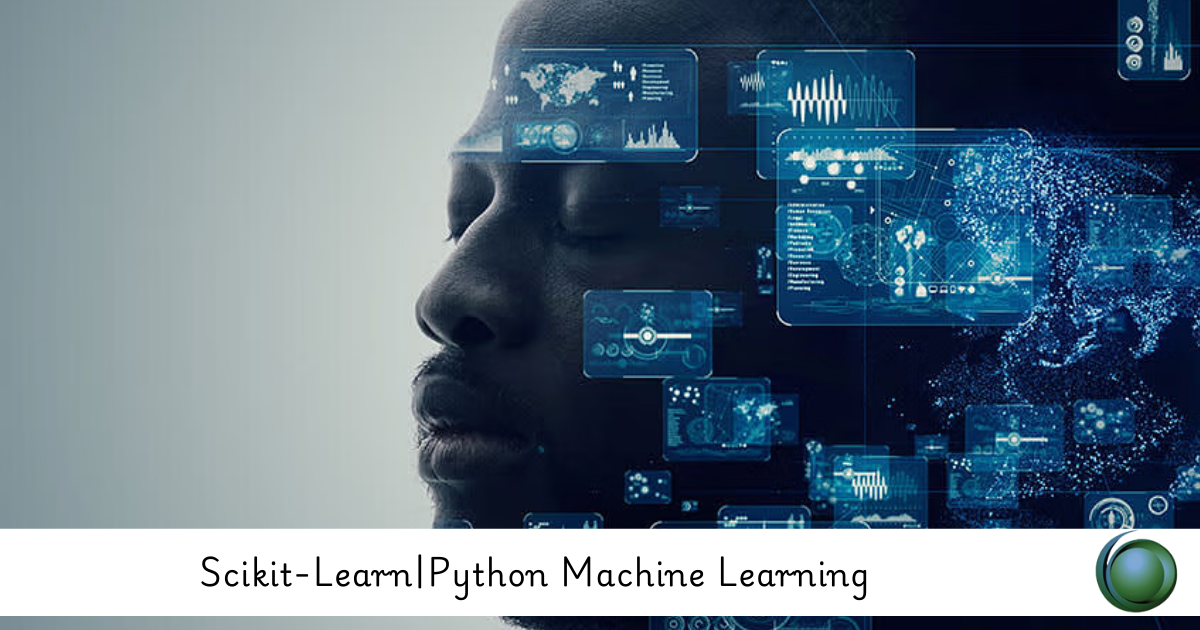Scikit-learn (Sklearn) is the most useful and robust library for machine learning in Python. It provides a selection of efficient tools for machine learning and statistical modeling including classification, regression, clustering and dimensionality reduction via a consistence interface in Python. This library, which is largely written in Python, is built upon NumPy, SciPy and Matplotlib.
Table of contents
1: The Machine Learning Landscape
1.1 What Is Machine Learning?
1.2 Why Use Machine Learning?
1.3 Types of Machine Learning Systems
1.4 Supervised/Unsupervised Learning
1.5 Instance-Based Versus Model-Based Learning
1.6 Main Challenges of Machine Learning
1.6.1 Insufficient Quantity of Training Data
1.6.2 Nonrepresentative Training Data
1.6.3 Poor-Quality Data
1.6.4 Irrelevant Features
1.6.5 Overfitting the Training Data
1.6.6 Underfitting the Training Data
1.7 Stepping Back
1.8 Testing and Validating
2: End-to-End Machine Learning Project
2.1 Working with Real Data
2.2 Look at the Big Picture
2.3 Frame the Problem
2.4 Select a Performance Measure
2.5 Check the Assumptions
2.6 Get the Data
2.7 Create the Workspace
2.8 Download the Data
2.9 Take a Quick Look at the Data Structure
2.10 Create a Test Set
2.11 Discover and Visualize the Data to Gain Insights
2.11.1 Visualizing Geographical Data
2.11.2 Looking for Correlations
2.11.3 Experimenting with Attribute Combinations
2.12 Prepare the Data for Machine Learning Algorithms
2.12.1 Data Cleaning
2.12.2 Handling Text and Categorical Attributes
2.12.3 Custom Transformers
2.12.4 Feature Scaling
2.12.5 Transformation Pipelines
2.13 Select and Train a Model
2.13.1 Training and Evaluating on the Training Set
2.13.2 Better Evaluation Using Cross-Validation
2.14 Fine-Tune Your Model
2.14.1 Grid Search
2.14.2 Randomized Search
2.14.3 Ensemble Methods
2.15 Analyze the Best Models and Their Errors
2.16 Evaluate Your System on the Test Set
2.17 Launch, Monitor, and Maintain Your System
3: Classification
3.1 MNIST
3.2 Training a Binary Classifier
3.3 Performance Measures
3.3.1 Measuring Accuracy Using Cross-Validation
3.3.2 Confusion Matrix
3.3.3 Precision and Recall
3.3.4 Precision/Recall Trade-off
3.3.5 The ROC Curve
3.4 Multiclass Classification
3.5 Error Analysis
3.6 Multilabel Classification
3.7 Multioutput Classification
4: Training Models
4.1 Linear Regression
4.2 The Normal Equation
4.3 Computational Complexity
4.4 Gradient Descent
4.4.1 Batch Gradient Descent
4.4.2 Stochastic Gradient Descent
4.4.3 Mini-batch Gradient Descent
4.5 Polynomial Regression
4.6 Learning Curves
4.7 Regularized Linear Models
4.7.1 Ridge Regression
4.7.2 Lasso Regression
4.7.3 Elastic Net
4.8 Early Stopping
4.9 Logistic Regression
4.9.1 Estimating Probabilities
4.9.2 Training and Cost Function
4.9.3 Decision Boundaries
4.10 Softmax Regression
5: Support Vector Machines
5.1 Linear SVM Classification
5.2 Soft Margin Classification
5.3 Nonlinear SVM Classification
5.3.1 Polynomial Kernel
5.3.2 Adding Similarity Features
5.3.3 Gaussian RBF Kernel
5.4 Computational Complexity
5.5 SVM Regression
5.6 Under the Hood
5.6.1 Decision Function and Predictions
5.6.2 Training Objective
5.6.3 Quadratic Programming
5.6.4 The Dual Problem
5.6.5 Kernelized SVM
5.7 Online SVMs
6: Decision Trees
6.1 Training and Visualizing a Decision Tree
6.2 Making Predictions
6.3 Estimating Class Probabilities
6.4 The CART Training Algorithm
6.5 Computational Complexity
6.6 Gini Impurity or Entropy?
6.7 Regularization Hyperparameters
6.8 Regression
6.9 Instability
7: Ensemble Learning and Random Forests
7.1 Voting Classifiers
7.2 Bagging and Pasting
7.2.1 Bagging and Pasting in Scikit-Learn
7.2.2 Out-of-Bag Evaluation
7.3 Random Patches and Random Subspaces
7.4 Random Forests
7.5 Extra-Trees
7.6 Feature Importance
7.7 Boosting
7.7.1 AdaBoost
7.7.2 Gradient Boosting
7.7.3 Stacking
8: Dimensionality Reduction
8.1 The Curse of Dimensionality
8.2 Main Approaches for Dimensionality Reduction
8.2.1 Projection
8.2.2 Manifold Learning
8.3 PCA
8.3.1 Preserving the Variance
8.3.2 Principal Components
8.3.3 Projecting Down to d Dimensions
8.3.4 Using Scikit-Learn
8.3.5 Explained Variance Ratio
8.3.6 Choosing the Right Number of Dimensions
8.3.7 PCA for Compression
8.3.8 Randomized PCA
8.3.9 Incremental PCA
8.3.10 Kernel PCA
8.3.11 Selecting a Kernel and Tuning Hyperparameters
8.4 LLE
8.5 Other Dimensionality Reduction Techniques
9: Up and Running with TensorFlow
9.1 Installation
9.2 Creating Your First Graph and Running It in a Session
9.3 Managing Graphs
9.4 Lifecycle of a Node Value
9.5 Linear Regression with TensorFlow
9.5.1 Implementing Gradient Descent
9.5.2 Manually Computing the Gradients
9.5.3 Using autodiff
9.5.4 Using an Optimizer
9.6 Feeding Data to the Training Algorithm
9.7 Saving and Restoring Models
9.8 Visualizing the Graph and Training Curves Using TensorBoard
9.9 Name Scopes
9.10 Modularity
9.11 Sharing Variables
10: Introduction to Artificial Neural Networks
10.1 From Biological to Artificial Neurons
10.2 Biological Neurons
10.3 Logical Computations with Neurons
10.4 The Perceptron
10.5 Multi-Layer Perceptron and Backpropagation
10.6 Training an MLP with TensorFlow’s High-Level API
10.7 Training a DNN Using Plain TensorFlow
10.7.1 Construction Phase
10.7.2 Execution Phase
10.8 Using the Neural Network
10.9 Fine-Tuning Neural Network Hyperparameters
10.9.1 Number of Hidden Layers
10.9.2 Number of Neurons per Hidden Layer
10.9.3 Activation Functions
11. Training Deep Neural Nets
11.1. Vanishing/Exploding Gradients Problems
11.2. Xavier and He Initialization
11.3. Nonsaturating Activation Functions
11.4. Batch Normalization
11.5. Gradient Clipping
11.6. Reusing Pretrained Layers
11.7. Reusing a TensorFlow Model
11.8. Reusing Models from Other Frameworks
11.9. Freezing the Lower Layers
11.10. Caching the Frozen Layers
11.11. Tweaking, Dropping, or Replacing the Upper Layers
11.12. Model Zoos
11.13. Unsupervised Pretraining
11.14. Pretraining on an Auxiliary Task
11.15. Faster Optimizers
11.16. Momentum Optimization
11.17. Nesterov Accelerated Gradient
11.18. AdaGrad
11.19. RMSProp
11.20. Adam Optimization
11.21. Learning Rate Scheduling
11.22. Avoiding Overfitting Through Regularization
11.23. Early Stopping
11.24. ℓ1 and ℓ2 Regularization
11.25. Dropout
11.26. Max-Norm Regularization
11.27. Data Augmentation
12. Distributing TensorFlow Across Devices and Servers
12.1. Multiple Devices on a Single Machine
12.2. Installation
12.3. Managing the GPU RAM
12.4. Placing Operations on Devices
12.5. Parallel Execution
12.6. Control Dependencies
12.7. Multiple Devices Across Multiple Servers
12.8. Opening a Session
12.9. The Master and Worker Services
12.10. Pinning Operations Across Tasks
12.11. Sharding Variables Across Multiple Parameter Servers
12.12. Sharing State Across Sessions Using Resource Containers
12.13. Asynchronous Communication Using TensorFlow Queues
12.14. Loading Data Directly from the Graph
12.15. Parallelizing Neural Networks on a TensorFlow Cluster
12.16. One Neural Network per Device
12.17. In-Graph Versus Between-Graph Replication
12.18. Model Parallelism
12.19. Data Parallelism
13. Convolutional Neural Networks
13.1. The Architecture of the Visual Cortex
13.2. Convolutional Layer
13.3. Filters
13.4. Stacking Multiple Feature Maps
13.5. TensorFlow Implementation
13.6. Memory Requirements
13.7. Pooling Layer
13.8. CNN Architectures
13.9. LeNet-5
13.10. AlexNet
13.11. GoogLeNet
13.12. ResNet
14. Recurrent Neural Networks
14.1. Recurrent Neurons
14.2. Memory Cells
14.3. Input and Output Sequences
14.4. Basic RNNs in TensorFlow
14.5. Static Unrolling Through Time
14.6. Dynamic Unrolling Through Time
14.7. Handling Variable Length Input Sequences
14.8. Handling Variable-Length Output Sequences
14.9. Training RNNs
14.10. Training a Sequence Classifier
14.11. Training to Predict Time Series
14.12. Creative RNN
14.13. Deep RNNs
14.14. Distributing a Deep RNN Across Multiple GPUs
14.15. Applying Dropout
14.16. The Difficulty of Training over Many Time Steps
14.17. LSTM Cell
14.18. Peephole Connections
14.19. GRU Cell
14.20. Natural Language Processing
14.21. Word Embeddings
14.22. An Encoder–Decoder Network for Machine Translation
15. Autoencoders
15.1. Efficient Data Representations
15.2. Performing PCA with an Undercomplete Linear Autoencoder
15.3. Stacked Autoencoders
15.4. TensorFlow Implementation
15.5. Tying Weights
15.6. Training One Autoencoder at a Time
15.7. Visualizing the Reconstructions
15.8. Visualizing Features
15.9. Unsupervised Pretraining Using Stacked Autoencoders
15.10. Denoising Autoencoders
15.11. TensorFlow Implementation
15.12. Sparse Autoencoders
15.13. TensorFlow Implementation
15.14. Variational Autoencoders
15.15. Generating Digits
15.16. Other Autoencoders
16. Reinforcement Learning
16.1. Learning to Optimize Rewards
16.2. Policy Search
16.3. Introduction to OpenAI Gym
16.4. Neural Network Policies
16.5. Evaluating Actions: The Credit Assignment Problem
16.6. Policy Gradients
16.7. Markov Decision Processes
16.8. Temporal Difference Learning and Q-Learning
16.9. Exploration Policies
16.10. Approximate Q-Learning and Deep Q-Learning
16.11. Learning to Play Ms. Pac-Man Using the DQN Algorithm
To conclude;
In this course, you’ve explored the essential concepts of machine learning using Scikit-Learn and Python, covering data preprocessing, model training, and evaluation. Continue applying these skills to real-world projects and explore advanced techniques for deeper insights.
If you are looking for customized info, Please you can contact here
Reference for Scikit-learn
Reference for Python
|







Reviews
There are no reviews yet.